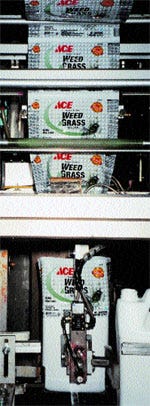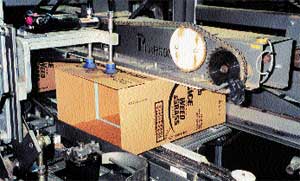Fancy labeling spiffs up lawn & garden lines
|
Labels, which are supplied on a roll, are pulled into labeler, cut, and slipped over the bottle. |
Spectrum Brands is a leader in the development and marketing of lawn and garden pesticides and herbicides, household insecticides, insect repellents, and fertilizers for customers such as Ace Hardware. Two years ago, the company decided to upgrade the stretch-sleeve labels on its bottles to enhance their shelf presence.
Spectrum asked its supplier of labeled bottles, C.L. Smith Co., St. Louis, MO, to establish a new label supplier that could provide enhanced graphics. C.L. Smith, a manufacturer of plastic bottles and a full-line distributor of containers, is a privately held corporation with more than 25 years of experience in the industry. The company supplies three sizes of labeled high-density polyethylene bottles to Spectrum–gallon and half-gallon for liquids, and square for granules. "We considered four label suppliers and decided on SleeveCo," says Ed Freesmeier, C.L. Smith's vp of marketing. "They provide excellent service, and a few years ago they installed a new eight-color flexographic press that produces beautiful graphics." The Spectrum labels are a two-part lamination consisting of 1.25-mil low-density polyethylene laminated to 1.25-mil LDPE with full-bleed printing between the layers. The LDPE is a proprietary blend engineered for better sealability and printability.
The 8-color, 37-in.-wide Vision II central-impression flexo press from Paper Machinery Converting Co. has an 11- to 24-in. (280- to 600-mm) repeat range and a maximum printing speed of 800 fpm. The unit's electronic, closed-loop deck positioning system helps ensure repeatability, and enables plates and rolls to be quickly changed. An onboard management information system (MIS) creates job recipes in its memory bank. Each time a job is repeated, the system provides the same setting as the first time it ran, so the labels look the same every time they're printed. "In the past, we had a lot of problems with size inconsistency. One roll of sleeves would be too big, and the next would be too small. The SleeveCo labels are the same every time," says Freesmeier. "And the printing is beautiful. Spectrum wants the art to pop out on the store shelf, and these labels really meet that requirement."
As part of the project, C.L. Smith installed a new SleeveCo Model SL-3000 automatic sleeve labeler. Says Freesmeier, "We already had two SleeveCo labelers on other lines, and they have done a good job for us. Plus, it's very advantageous to have both the labels and labeler from one company in case any problems arise." The project also included a new Proco leak tester, a Climax case packer and a Pearson case former.
The labeler has a maximum operating speed of up to 50 bottles/min, but was running about 40/min during Packaging Digest's visit. Labels are supplied on a roll, which is mounted on the back of the intermittent-motion machine. The machine is built to sit over the conveyor, and bottles are transferred into the sleeving section for sleeve application. Bottles are stopped at the entrance to the machine by a gate and are released one at a time.
A pusher moves the bottle back beneath the sleeve-application mandrel, and a sleeve is cut from the roll and pulled down over the bottle. Once it is in place, the bottle is pushed back out onto the conveyor, and the cycle is repeated. All of the main operations of the machine are electromechanically driven by a programmable logic controller. The SL-3000 is designed for quick changeover from one size container to another by changing tooling and the sleeve labels, which can be done in less than 20 minutes.
Bottles are leak-tested with air before labeling, top right. Reciprocating arm with grippers picks up four bottles from conveyor and places them into shipper, bottom right. Case erector, bottom left, sets up cases. | |
|
C.L. Smith blow-molds the bottles for Spectrum and either stores them on pallets until needed, or delivers them directly to the new labeling operation on a conveyor. The first operation in the new line is a four-head, intermittent-motion leak tester from Proco Machinery Ltd. A photoelectric sensor monitors the flow of containers into and out of the test area, and a pneumatic gate system ensures that the containers are accurately located beneath the test heads. Each head has a totally independent test system. The heads descend over the tops of the bottles, and air is admitted to a pressure of about 1 psig. In this procedure, an illuminated column ascends as the air is injected into the container. If the container leaks, the illuminated column descends at a rate equal to the size of the leak. Once the column descends below the preset reject point, a defect is indicated, and the container is ejected. This feature makes setup and monitoring of the system simple. Leaks as small as 0.0001 in. dia can be detected in less than one second. Containers that fail are ejected as they leave the machine.
After labeling, the bottles are conveyed to a Model LD drop packer from Climax Packaging Machinery. The machine is equipped with a SOF-PAC® attachment that is designed to softly place containers onto the bottom of the case. Bottles are separated into four lanes as they enter the machine, and a reciprocating arm with four grippers swings over and lifts the bottles by their handles. It then swings back, rotates 180 degrees, and lowers to place them upside-down into the shipping case. C.L. Smith installed a Pearson Model R235 case erector with bottom sealing to erect knocked-down cases. Vacuum cups mounted on a rotating mechanical arm pick up a case from the magazine and rotate it 90 degrees to place it into the setup station. Top and bottom vacuum cups engage the blank, and a mechanical setup arm erects the case in the direction of flow.
Once erected, both leading and trailing minor flaps are closed by pneumatic rotary actuators. As the case is transferred to the compression station, hot-melt adhesive is applied to the minor flaps. The case erector incorporates an Allen-Bradley PLC and a photoeye at its discharge, as well as a Nordson Corp. hot-melt unit and quick changeover features.
More information is available:
Bottle manufacturer: C.L. Smith Co., 314/771-3351. Circle No. 247.
Labels, labeler: SleeveCo, Inc., 706/216-3110. Circle No. 248.
Leak detector: Proco Machinery Ltd., 905/206-9392. Circle No. 249.
Drop packer: Climax Packaging Machinery, 513/874-1233. Circle No. 250.
Case former: Pearson Packaging Systems, 509/838-6226. Circle No. 251.
PLC: Allen-Bradley, 414/382-2000. Circle No. 252.
Hot-melt glue system: Nordson Corp., 770/497-3700. Circle No. 253.
Press: Paper Machinery Converting Co., 920/494-5601. Circle No. 254.
About the Author(s)
You May Also Like




